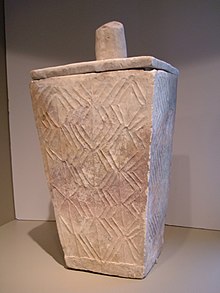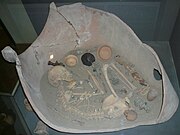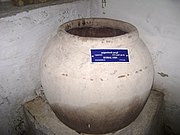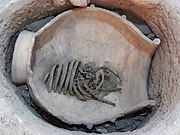Métodos
A cultura do sepultamento JAR foi empregada por povos que escolheram essa prática para enterro primário ou secundário. Enterro primário refere -se aos atos realizados no corpo imediatamente após a morte. Em alguns casos de enterro JAR, o enterro primário com essa técnica era muito mais difícil de realizar. Nas sociedades de Creta, o cadáver estaria firmemente ligado para caber no pote desejado. Acredita -se que isso fosse originalmente destinado a bebês e crianças pequenas, mas evoluiu para categorias maiores de adultos. O enterro adulto, no entanto, exigiu frascos muito maiores, sepulturas mais profundas e mais poder de homem. Nas sociedades egípcias, o corpo também podia ser sentado na posição vertical e, em seguida, a jarra seria forçada no topo do corpo. Os egípcios também colocavam o corpo no jarro, em vez de empurrar o frasco para baixo, mas isso criaria a necessidade de uma tampa. As tampas não são peças específicas de cerâmica, foram consideradas tão simples quanto uma rocha ou outra jarra. A preferência de como o corpo foi colocado não tinha nenhum significado certo.
Enterros secundários são atos diferentes realizados no corpo que já foram enterrados. O tempo alocado entre enterros primários e secundários varia entre as culturas, no entanto, é dada uma ênfase à espera até que o corpo se decompuse, e qualquer técnica seja realizada como "secundária", está lidando com apenas ossos com carne removida. Com os enterros do JAR, os ossos, a carne removidos, foram limpos e posteriormente colocados em uma jarra.
Adições de jarra
Os tipos de frascos e componentes adicionais variam de localização para cultura. Diferentes formas de frascos podem indicar o prestígio ou o nível social do falecido, ou pode ser um frasco comum. Às vezes, as ofertas funerárias são colocadas dentro ou ao redor dos frascos, revelando mais informações sobre o valor que diferentes povos têm para certos itens.
Decoração
Os pithoi eram frascos de armazenamento típicos e eram comumente usados para enterros e empregam alças verticais para redondos a ovais. Também foram encontradas esculturas em frascos, às vezes representando seres divinos locais da época. Pensa -se que isso ajude na passagem desse indivíduo para um reino além da vida. As esculturas nos frascos não são padronizadas, o que significa que não há um padrão particular de uma certa escultura em vários frascos, mas a maioria das esculturas foi observada no Egito.
Alguns frascos são fabricados especificamente para enterros de jar, devido ao tamanho variável de corpos e sites graves disponíveis para diferentes culturas.
Acessórios
Muitos locais de sepultamento JAR também foram acompanhados por mais do que apenas os esqueletos e potes. Minchas, espadas, espelhos e outros ossos de animais foram encontrados dentro e ao redor de potes. Nas montanhas cardamom, uma grande quantidade de contas foi encontrada em potes. Essas são as ofertas mais provavelmente para o falecido, da mesma maneira que os túmulos têm presentes neles. No entanto, a presença dessas contas e outras ofertas fornece uma grande visão do estilo de vida do povo. Ao estudar os materiais e métodos de que as contas foram feitas, os pesquisadores conseguiram vincular várias culturas com base em suas prováveis operações comerciais - a maneira como obtiveram contas exoticamente diferentes do que era típico de sua própria cultura.
Galeria
Mulher em um jarro de enterro da cultura de jarro-burial de Mingachevir, Azerbaijão
Um pote de enterro do século I CE em Kalugumalai, Tamil Nadu (exibido no Museu Folk Arts, Courtallam)
Jarro de enterro da cultura sa huỳnh do Vietnã
Jarro de enterro do sítio arqueológico de Cát Tiên do Vietnã
O Jar Manunggul (890–710 aC) de Tabon Cave, Palawan, Filipinas
Enterros infantis no Irã, geralmente colocados em casas, como na região da Palestina
Cemitério jarra de enterro japonês
Locais geográficos de enterros de jar
LocationDatesCultural SpecificsCambodiaAD 1395 – 1650 In the Cardamom Mountains specifically, a mass burial site with over 152 individuals was discovered. Using radiocarbon dating, researchers were able to indicate that this specific site was only an active burial site for about 15 years. In addition to human remains, they were able to genetically identify animal bones also (pigs, dogs,). These findings were deduced to have been placed with the grave as offerings. When analyzing the jars themselves, they were identified as being jars obtained through maritime trading or local ceramic production. Egypt--In Egypt, prior to using an embalming process, there is evidence that they practiced jar-burial. They used hemispherical and bowl urns, and the shape was not indicative of any external meaning. Some jars found here had inscriptions on the outside resembling common deities worshipped by the Egyptian people. Indonesiaca. 1st – 2nd millennium AD Jar burials are known from Java, Sumatra, Bali, Sulawesi, Salayar Island, and Sumba. Most sites are found in eastern Indonesia, with the burials restricted to coastal areas. Iran–In Iran, we do not find any items accompanying the burials, and no indication of offerings. However, this area is dictated by tropical conditions, and these conditions resulted in frequent and repeated flooding resulting in sites and artifacts that were not well preserved Japan300 BC - AD 300Jar Burial was practiced in Japan for about 600 years. Sites here show the most intricate planning of burial sites, and the planning reflected a social hierarchy within the site. Certain areas of the site had multiple burials clumped together, with the most recent death buried closer to the surface, and the oldest would lie deeper and underneath the recent deaths. These clumps all faced each other, so when the site was opened again to bury someone new, all of the clumps were 'connected' and more inviting to the person about to be buried. Within clumps, most have offerings in or around the graves. Offerings plus the intricate planning of the site indicates that a lot of care was put into the disposal of the dead in this culture. Lebanon--In the sites discovered, Lebanese jar burials were particularly reserved for infants. It was rare to find an adult who had been buried in a jar. Malaysia1150 BC – 300 BC Burial jars have been found in the Niah Caves of Sarawak. Palestine–Palestinian jar burials were done as "Subfloor burial", in which they were buried under floors in rooms of the house. The areas chosen were mostly high traffic areas where household tasks were performed, thus connecting them with the main parts of everyday life. In these burials there were occasional materials found with the bodies such as shells, but there has been no evidence that these were placed with the bodies as offerings. Philippines1581 BC – AD 1460±180 The practice of jar burial was widespread in the Late Neolithic period of the Philippines, with archeological examples from northern Luzon, Marinduque, Masbate, Sorsogon, Palawan, and in Sarangani in Mindanao. They were usually placed in caves and are made from clay or carved stone. The oldest dated jar burial fragments are from the Dalan Serkot Caves in Cagayan Valley, radiocarbon dated to around 1581+34 BC (1947–1753 cal. BC). The most recent jar burial remains are from Banton Cave in Banton, Romblon island; and Balisong Cave in Pilar, Panay island. They have been dated to around the 13th to 17th centuries AD. The oldest intact example is the Manunggul Jar from the Tabon Cave, dated to 890–710 BC. SumatraAD 700 - 1500 Secondary burial was carried out using the jar burial method. The only other additions of note were shards of pottery found in some urns with the bodies. Syria1800 BC - 1750 BCSyrian jar burial was noted to have been practiced for a short period of time. The vessels used to bury individuals in did not always happen to be jars; they ranged from pots to goblets, and had pins and cylinder seals inside. Taiwan--Typical to Austronesian Indigenous Taiwanese jar burial, glass beads were laid to rest within the jars along with the body. Jar burial was used as a means of secondary burial here. Thailandca. last centuries BC Upon extensive testing, studies have shown that individuals buried in jars had different diets than other inhabitants of Thailand. This suggests a different social status of those buried in jars, or that those individuals were immigrants and brought that practice with them to Thailand. Vanuatu--In Vanuatu, almost all jar burials were found with ceramic fragments in the jars. It is unclear whether those are shards of other broken jars or if they were placed in the jars as offerings. Vietnam--Burial jars in Vietnam are mostly from Austronesian sites in southern and central Vietnam. The most notable are burial jars from the Sa Huỳnh culture.
Veja também
Canopic jarPlain of JarsHanging coffins














